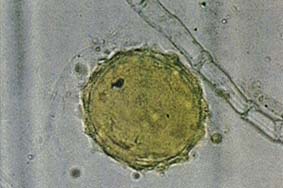Image Details

Microphotography by Uri Baruch/Courtesy Alan Whanger
Only one tape from Frei’s samples was tested by the authors of Flora of the Shroud of Turin at a higher resolution than they normally used (400×) with light microscopy. Some pollen from the sticky tape pull known as 6Bd was studied using immersion oil (which makes it easier to see the grain and which could not be done on other samples because of their deterioration) and then magnified 1,000 times. But this photo from the book, of a pollen grain and a cloth fiber from sticky tape 6Bd, shows the grain magnified only 160 times—a decision not explained by the authors. The authors of the book claim the grain is Gundelia tournefortii. Bryant asserts, however, that this photograph cannot be used to prove that the grain is Gundelia tournefortii because the cytoplasm and other debris obscure the details of the pollen surface and wall structure that are so critical in pollen identification. If he were called as an expert witness in a court of law, Bryant writes, he would testify that based on current knowledge, the pollen grains presented in Flora of the Shroud of Turin could not be confidently identified as Gundelia tournefortii.
